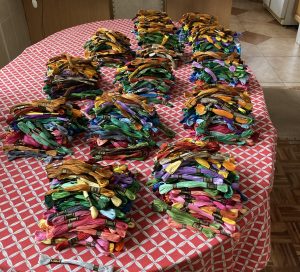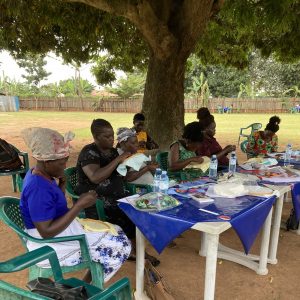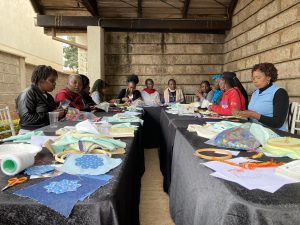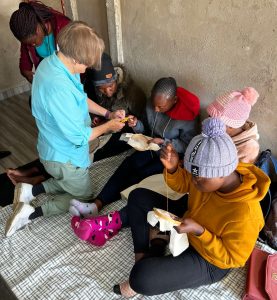I don’t remember if the motto “Be Prepared” is from the Boy Scouts or the Girl Scouts but I do know that it often comes to mind as we begin embroidery training in different places. As a teacher, I’ve always prepared lesson plans and materials well in advance of a class. Students need to have confidence in their instructor and to know that the person in front of them (or beside them or behind them) has something more to offer than they already know.
 So, in coming to Africa to continue embroidery training for four groups of women and girls, almost all of whom had done at least one embroidery with AP, I prepared and prepared and prepared some more. I tried to consider the contingencies and think about the materials we would need but might not be able to get locally. My suitcase and backpack were filled with embroidery hoops, fabric, books, and literally thousands of skeins of embroidery floss.
So, in coming to Africa to continue embroidery training for four groups of women and girls, almost all of whom had done at least one embroidery with AP, I prepared and prepared and prepared some more. I tried to consider the contingencies and think about the materials we would need but might not be able to get locally. My suitcase and backpack were filled with embroidery hoops, fabric, books, and literally thousands of skeins of embroidery floss.
I even jettisoned a couple of extra shirts to make room for the ever-increasing load of supplies. I had written out a plan for each day and rehearsed, to a degree, my opening remarks to put everyone at ease.
 But then, as every teacher knows, reality hits. The training venues required me to adapt my plans from the first moment. In Zimbabwe we were in a rather small room in a tin-roofed structure which had two window openings and a single overhead light. Threading needles in good light can be a challenge but in dim light it can be an ordeal. Just moving among the fifteen active and talkative girls required agility as some sat on the floor, others on two small couches and some behind a table – remember, this was a very small room!
But then, as every teacher knows, reality hits. The training venues required me to adapt my plans from the first moment. In Zimbabwe we were in a rather small room in a tin-roofed structure which had two window openings and a single overhead light. Threading needles in good light can be a challenge but in dim light it can be an ordeal. Just moving among the fifteen active and talkative girls required agility as some sat on the floor, others on two small couches and some behind a table – remember, this was a very small room!
I had to step over legs, reach across some girls to reach others, and often found myself on my knees to be able to assist with issues. If a needle was accidentally dropped, the barefooted participants were all alerted to be on the lookout and to tread carefully.
Uganda took us to outdoor training under the beautiful mango tree. This presented two different, unanticipated issues: 1) falling mangos, which hurt when they hit and 2) no windows. One of my strategies for transferring embroidery designs from paper to fabric is to tape the paper to a window, tape the fabric over the paper, and trace the design. You can’t do that without windows! I found a different way, a little more time-consuming but we all learned. By the way, the mango dropping was a windfall for the ladies as they left each day with these sweet treats to take home to their families.
 In Kenya we are once more meeting outdoors – or rather we are meeting in a covered area, open on two-sides, which might be outdoor living space but is somewhat akin to a carport. Again, we have no but I’m now prepared for that. We have poor light, but I got some new needles with larger eyes. It rained a little yesterday, but we just crowded closer under the covered area and carried on. We also had to be aware of the monkeys coming if we had food out. They don’t like to be told “no!”
In Kenya we are once more meeting outdoors – or rather we are meeting in a covered area, open on two-sides, which might be outdoor living space but is somewhat akin to a carport. Again, we have no but I’m now prepared for that. We have poor light, but I got some new needles with larger eyes. It rained a little yesterday, but we just crowded closer under the covered area and carried on. We also had to be aware of the monkeys coming if we had food out. They don’t like to be told “no!”
I’m not registering these challenges as any kind of complaint, nor am I intending to show that I’m a super-teacher who can cope with any adversity. Rather, this is to show that when you want to accomplish something you can if you don’t let adjustments to the plan stand in your way and if you encourage creative thinking,
 And these students are creative thinkers. They have taught me a lot in these past four weeks and they have taught each other. When I see students helping each other, I tell them that when you teach, you improve your own learning and many times you learn something new yourself. I know that I have continued to learn as I’ve taught these different groups of students in very different surroundings. I hope they’ve learned what I had prepared in my lesson plans. But I also hope they will continue to learn from and to each other as they become more proficient with each block.
And these students are creative thinkers. They have taught me a lot in these past four weeks and they have taught each other. When I see students helping each other, I tell them that when you teach, you improve your own learning and many times you learn something new yourself. I know that I have continued to learn as I’ve taught these different groups of students in very different surroundings. I hope they’ve learned what I had prepared in my lesson plans. But I also hope they will continue to learn from and to each other as they become more proficient with each block.
Posted By Barbara Fitzsimmons
Posted Jul 24th, 2022




1 Comment
Mary
August 21, 2022
Love reading your blog and looking forward to seeing all the wonderful new blocks from your students.
Safe travels.